BestReviews is reader-supported and may earn an affiliate commission. Details
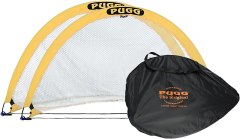
A set of two goals that weigh 7 pounds and are easy to assemble and fold.
Includes two goals, stakes, storage bag, and extra parts. Features a nylon net with nylon fabric edging. Frame is made of steel. Pops open with a twist and folds compactly.
More expensive than some other options.
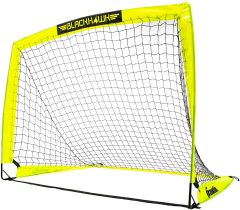
An easy-to-assemble and transportable soccer goal available in 4 different sizes to fit your practice needs.
The fiberglass and steel beams are easy to put up and take down. Stakes make it sturdy on most applicable surfaces. The goal is light and easy to carry to your favorite practice spot. Great for practice and games at the park.
Only comes with 1 goal. Not ideal for leagues.
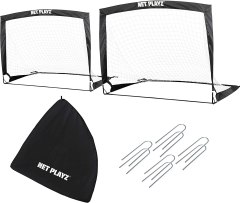
A two-pack of rectangular goals with a fast and easy fold.
Set of two structured goals measuring 4 feet long by 3 feet high. Frame is made of sturdy fiberglass poles and net can withstand rain. Easily opens up and folds into carrying bag. Includes a set of 8 metal stakes.
Rods can occasionally snap.
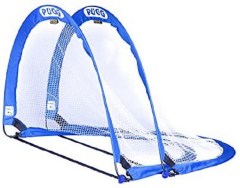
A set of compact soccer goals that can be used on various surfaces.
Includes two goals, stakes, storage bag, and extra parts. Has a knitted poly net and steel frame with nylon fabric cover. Sets up easily with a twist. Measures 2.5 feet tall by 4 feet wide. Weighs only 4 pounds.
Best suited for younger players.
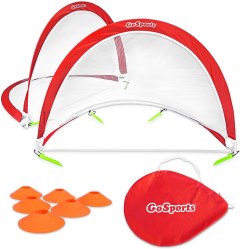
A set of two well-made goals that includes cones and stakes.
Four-foot round goals available in other sizes. Comes with two goals, six orange cones, a storage bag, and plastic and metal stakes. Made of fiberglass poles and nylon fabric and netting. Pops open and folds for storage.
May be lacking in durability.
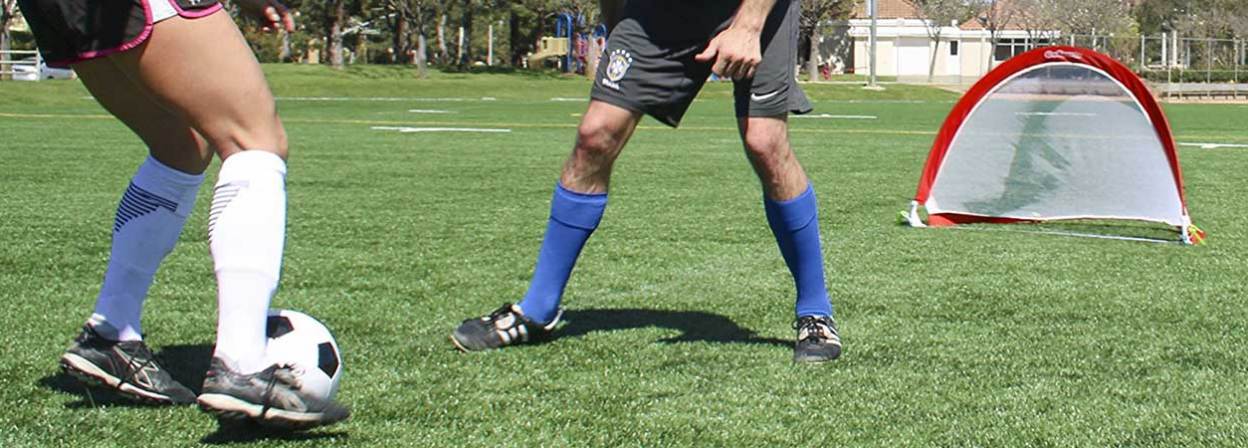
We recommend these products based on an intensive research process that's designed to cut through the noise and find the top products in this space. Guided by experts, we spend hours looking into the factors that matter, to bring you these selections.

If you’re in the mood to play soccer, you can drive around town looking for a regulation field — or, you can create your own soccer field with portable pop-up soccer goals. Whether you need them for practice or a pickup game, you can turn any open space into a soccer field with portable pop-up soccer goals.
These units include soccer goal posts, as well as a net to catch the ball as it goes into the goal. Unlike the box frame of a regulation soccer goal — whereby the top of the frame extends horizontally away from the goal line, then angles downward toward the bottom of the frame — pop-up soccer goals simply sport a frame with a net that extends directly from the top bar to facilitate portability.
Portable pop-up soccer goals are perfect for practice, young players, or a recreational backyard game. But not all units are created equal. Read on to find the set that best suits your needs.

Where the box frame of a regulation soccer goal creates space for the goaltender to step inside the goal — an advantageous position in certain defensive schemes — a portable goal usually doesn’t leave enough room inside the net for the goaltender to stand upright under it. The net hangs directly from the top of the frame and angles downward.
Because a regulation goal uses a net with depth, the ball stays inside the goal, making it easy for the official to determine that a goal has been scored. A portable goal doesn’t have any depth, so the ball may bounce off the net and back into the field of play. For the purposes of practice or a pick-up game, however, this usually doesn’t pose a problem.
When playing a soccer game with young children, a smaller goal tends to be more appropriate than a regulation goal. With a 8 x 24 feet opening, a regulation goal usually leaves too much space for a young goaltender to cover.
For children 6 years-old and under, a goal measuring 4 x 6 feet is usually the best option.
For children between 6 and 10 years-old, portable goals measuring 6 x 12 feet may work well for games.
For pre-teens, goals with an opening up to 6 x 18 feet tend to be appropriate.
Teens and adults are perfectly capable of playing with regulation-sized goals measuring 8 x 24 feet.
Even the narrowest pop-up goals, measuring, say, 2.5 x 4 feet, can be useful for players of all ages, but they tend to work best for drills or casual pick-up games.
You want to have high quality materials in your pop-up goals, ensuring that it will last longer.
Plastic or PVC: Pop-up portable soccer goals often use plastic or PVC frames. Plastic models are usually inexpensive and have a bit of give, whereas PVC versions are firmer, providing more durability than plastic.
Metal: At the larger end of the spectrum, portable goals may use metal in the frame, typically aluminum. While metal posts last longer, they’re usually more expensive than plastic and PVC. Metal frames are more common among permanently installed soccer goals than they are among portable goals.
Mesh or rope nets: The net in a portable soccer goal is usually made of inexpensive nylon. With its thin diameter mesh, it likely won’t stand up to heavy use. Larger portable goals may use a net with a sturdy rope mesh, like you’d find in a regulation goal.
D-Shape: A D-shaped portable goal has a curved top bar that attaches to a horizontal base bar. (It looks like the letter D turned on its side.) The base bar delivers stability to the goal, while the curved top bar makes the goal easily portable. It does cut down on the size of the goal mouth, however, so shots aimed toward the upper corners that would count as scores in a regulation goal would sail past the curved top bar of a D-shaped goal.

Inexpensive: The least expensive pop-up goals carry a price tag of $20 to $40. These goals are typically much smaller than regulation goals — usually 4 feet or less in width. You can sometimes find a pair of goals in this price range, in which D-shaped goals are common.
Mid-range: Among portable soccer goals in the $40 to $100 range, you’ll find both D-shaped and rectangular models measuring 4 to 8 feet in width. Pairs of goals are more common in this range.
Expensive: Portable soccer goals costing $100 to $250 tend to be larger and rectangular in shape, with some units approaching regulation size. That said, the larger the size of the goal, the less likely it will come with a matching pair.
For many coaches, a portable soccer goal serves as a perfect tool for practice sessions. Whether you’re a coach or drilling among friends, here are some tips to help you use your portable goal more effectively in a practice setting.
Work on improving shot accuracy. Because portable goals tend to be smaller in size than regulation goals, players have to be more accurate when shooting.
Elevate your skills with reduced player games. The smaller goal mouth is perfect for games comprised of fewer players, such as a goaltender-less 3-on-3 match.
Keep more players engaged. Rather than having 15 players standing around while one player does a drill using a regulation goal, you can have multiple players working on drills simultaneously with several relatively inexpensive portable goals.
Move the goal to different locations. Portable units make it easy to move the goal around the field for different drills, helping you avoid too much wear and tear in one area of the field.
Soccer players will love using the portable goals we’ve listed in our matrix. However, if you’re looking for options with a few extra features, here are some other pop-up soccer goals we considered.
The QuickPlay Q-Fold Soccer Goal comes in sizes up to 16 x 7 feet, which is closer to regulation than most portable goals. With enough experience using it, it can be installed in less than a minute.
Another rectangular pop-up soccer goal option is the Rukket Portable Soccer Goal. At 8 x 6 feet, it’s not as big as the Q-Fold — but it is a worthy option at a cheaper price point.
We also like the size of the pop-up D-shaped Forza Flash Soccer Goal set of two. Each goal measures 6 feet in width, which is large for this style of goal.
For an inexpensive option, we like the AmazonBasics Pop-Up Goal set of two. Each goal is only 2.5 feet in width, though wider options are available at a higher price.

Q. Is a portable soccer goal safer than a permanently installed goal?
A. A permanent goal usually consists of thick, metal posts that do not give when a player crashes into them. A portable pop-up goal often consists of plastic posts that collapse when a player runs into them. If you’re worried about a player crashing into posts, a portable goal will help set your mind at ease.
Q. What shapes of pop-up portable soccer goals are available?
A. Some pop-up goals have a sideways D shape, with the straight line of the D along the ground and the curved line along the top. Others have a more rectangular shape, similar to (albeit smaller than) a traditional soccer goal. A D-shaped goal helps players learn to shoot the ball low to the ground, while rectangular-shaped goals allow for traditional practice shots.
Q. Does a portable soccer goal fold down to an easy-to-carry size?
A. Yes. These goals are designed to be easy to carry with you anywhere. Sometimes the poles pop apart, meaning you can carry the parts separately. Others will fold together, almost like a windshield sunshade you’d use in a car.
Q. How durable are these portable goals?
A. Durability and longevity vary quite a bit from product to product. Some portable pop-up soccer goals will consist of excellent materials, making them a good value. Others are cheaply made and may break the first time someone trips over them.
Get emails you’ll love.
Learn about the products you’re wondering if you should buy and get advice on using your latest purchases.
